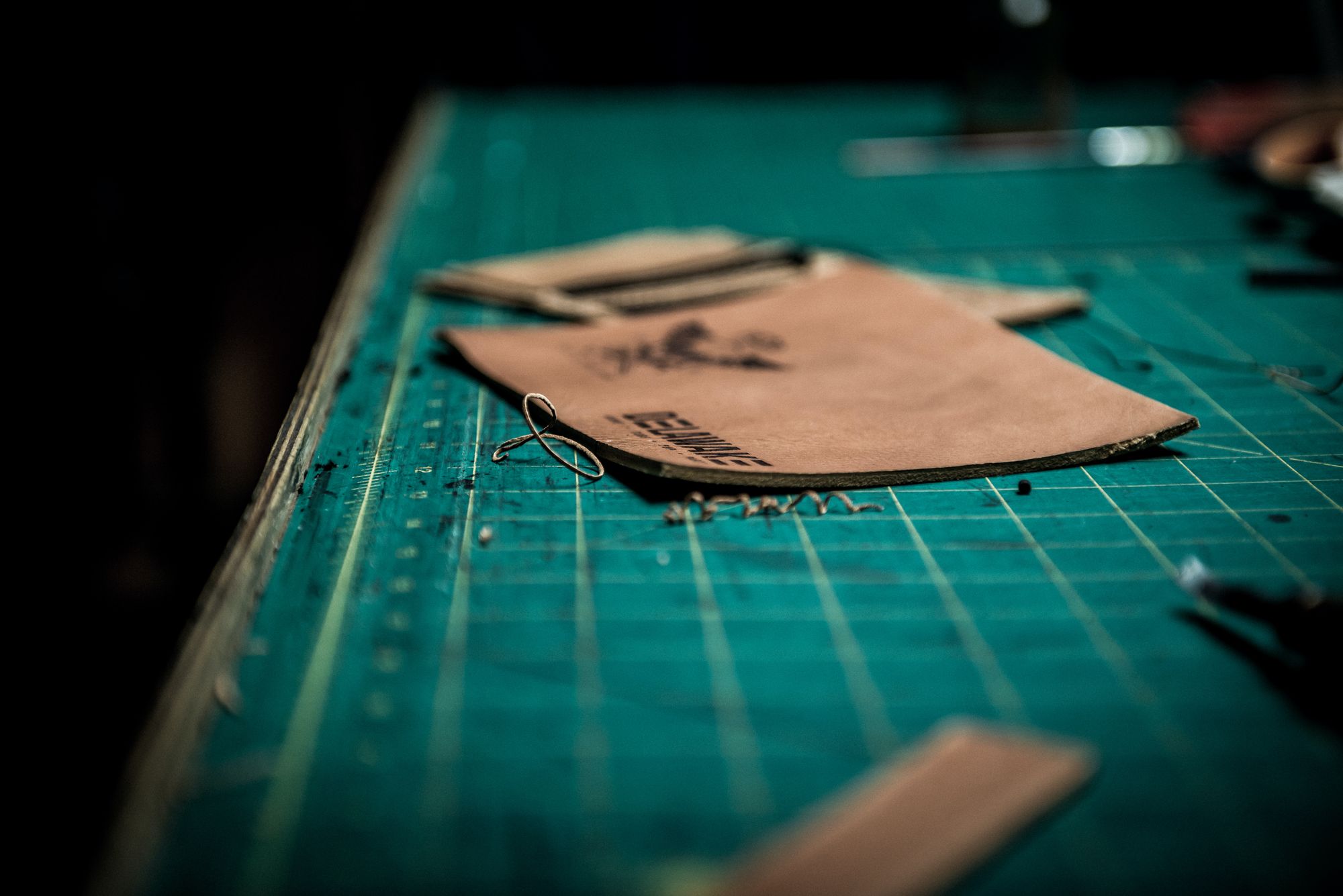Are you tired of waiting for the perfect leather product that meets all your expectations? Well, the good news is that leather manufacturing is evolving to meet the needs of today's fast-paced world.
The leather industry is a major contributor to the US economy, with the market expected to reach $85.05 billion by 2028. However, as the demand for leather products continues to grow, the industry is facing significant challenges in improving efficiency and sustainability.

In this article, we'll explore the latest strategies for improving the efficiency of leather manufacturing processes, including advanced technologies and sustainable practices.
So, if you're interested in how the leather industry is adapting to meet the needs of modern consumers, read on!
Here's what we shall cover in this post:
- Introduction to Efficiency in Leather Manufacturing
- Reducing Raw Material Waste
- Optimizing Production Line Processes
- Upgrading Machinery and Equipment
- Implementing Lean Manufacturing Principles
- Adopting Automation Technologies in Leather Manufacturing
- Investing in Skilled Workforce Training
- Streamlining Supply Chain Management in Leather Manufacturing
- Conclusion
- Key Takeaways
Introduction to Efficiency in Leather Manufacturing
Leather manufacturing is a complex process that involves multiple stages and requires significant resources. Improving efficiency in this industry can help companies save time, reduce waste, and cut costs, leading to increased profitability.
- Efficiency in leather manufacturing refers to the ability of a company to produce high-quality leather products while minimizing waste and maximizing resources.
- This can be achieved through various means, such as optimizing production processes, reducing the use of raw materials, and minimizing energy consumption. By improving efficiency, leather manufacturers can reduce costs and increase their competitiveness in the market.
- Leather manufacturing involves several stages, including tanning, dyeing, and finishing. Each stage requires careful attention to detail to ensure that the leather produced is high quality.
- Inefficient processes can lead to quality issues, such as uneven coloring or poor texture, resulting in the loss of valuable resources and negatively impacting the company's reputation.
Improving efficiency in leather manufacturing requires a comprehensive approach that involves identifying areas where waste is occurring and implementing measures to minimize it. This can include using automated equipment to improve the accuracy and speed of production processes, reducing the use of chemicals and water, and implementing recycling programs to minimize waste.
Reducing Raw Material Waste
The process of transforming animal hides into usable leather involves many stages, from tanning and dyeing to cutting and sewing. However, this process generates significant amounts of waste, including raw material waste, which can be costly for manufacturers and have negative environmental impacts.
Reducing raw material waste in leather manufacturing is an important challenge that manufacturers must address. Here are some strategies to help reduce raw material waste in leather manufacturing:
Accurate Measurement and Cutting
Accurate measurement and cutting of the leather are crucial to minimizing raw material waste. The use of advanced cutting machines and laser cutting technology can ensure precision in cutting leather, which can help reduce the amount of waste produced during the process. Using software systems to optimize the cutting process can also minimize waste.
Recycling and Reusing Scraps
Leather manufacturers can recycle and reuse scraps generated during the cutting process, which can help reduce raw material waste. Scraps can be used to make smaller leather products such as wallets and keychains or ground up and used as a raw material for other industries such as textiles.
Improved Inventory Management
Improved inventory management can help reduce raw material waste by minimizing overstocking and underutilization of leather hides. By accurately tracking inventory and production, manufacturers can reduce waste by only ordering the leather hides they need and using them efficiently.
Minimizing Errors in Production
Errors during the production process can lead to significant amounts of waste. Manufacturers can reduce these errors by ensuring that staff receives proper training and using quality control procedures to detect and correct mistakes before they result in waste.
Use of Sustainable Materials
The use of sustainable materials, such as recycled leather or synthetic alternatives, can help reduce raw material waste in leather manufacturing. These materials can be used in place of traditional animal hides, reducing the waste generated during production.
Optimizing Production Line Processes
Implementing Lean Manufacturing Principles
One way to optimize production line processes in leather manufacturing is to implement lean manufacturing principles. This involves identifying and eliminating waste in production, such as overproduction, waiting time, transportation, processing, inventory, motion, and defects.
Leather manufacturers can improve efficiency, productivity, and profitability by streamlining the production process and reducing waste.
Investing in Automation
Another strategy for optimizing production line processes in leather manufacturing is to invest in automation. This involves using machines and robots to perform repetitive or dangerous tasks, such as cutting, sewing, and finishing.
Automation reduces labor costs and improves accuracy, consistency, and speed. Leather manufacturers can also use sensors and data analytics to monitor and optimize production processes in real time.
Using Just-in-Time (JIT) Inventory Management
Leather manufacturers can also optimize production line processes by using just-in-time (JIT) inventory management. This involves ordering and receiving materials and supplies just in time for production rather than stockpiling them in inventory.
By reducing inventory, leather manufacturers can save on storage and transportation costs and reduce the risk of waste and obsolescence.
Implementing Quality Control Measures
Quality control is essential for optimizing production line processes in leather manufacturing. This involves monitoring and inspecting products throughout the production process to ensure that they meet the required quality standards.
By detecting and addressing defects early on, leather manufacturers can reduce waste, rework, and customer complaints. Quality control measures can also help improve customer satisfaction and loyalty.
Providing Training and Development Opportunities
Another way to optimize production line processes in leather manufacturing is to provide employee training and development opportunities. By investing in workers' skills and knowledge, leather manufacturers can improve their efficiency, productivity, and motivation.
Training can also help employees learn new techniques and technologies, which can lead to process improvements and innovation.
Upgrading Machinery and Equipment
Upgrading machinery and equipment in leather manufacturing can significantly improve efficiency and reduce waste. Here are some points to consider when upgrading machinery and equipment in leather manufacturing:
- Evaluate the existing machinery and equipment: Before considering an upgrade, assessing the current machinery and equipment in use is essential. Analyze each machine's age, efficiency, and productivity to determine which needs upgrading.
- Determine the specific requirements: After evaluating the current machinery and equipment, determine the specific requirements of the upgraded machinery. Consider the expected increase in production volume, the necessary speed of operation, and the features required for efficient and reliable operations.
- Invest in modern technology: Upgrading to modern machinery and equipment can significantly boost efficiency, productivity, and profitability. Newer machines may feature advanced technology, such as automated control systems, which can improve the quality and consistency of the final product while minimizing waste.
- Consider the environmental impact: Upgrading to more environmentally-friendly machinery and equipment can help reduce the carbon footprint of the leather manufacturing process. Some newer machines feature advanced energy-saving technologies that can help reduce energy consumption and greenhouse gas emissions.
- Ensure compatibility with existing equipment: When considering an upgrade, ensure that the new machinery and equipment are compatible with the existing equipment. Compatibility issues can lead to delays and disruptions in production and may lead to additional costs.
- Provide training and support: Investing in new machinery and equipment requires significant time and money. It is crucial to provide training and support to the employees who will be operating the new machines to ensure they can operate them efficiently and safely.
- Regular maintenance: Regular maintenance is crucial to ensuring that upgraded machinery and equipment operate efficiently and effectively. It is essential to schedule regular maintenance checks and repairs to prevent breakdowns and minimize downtime.
Implementing Standard Operating Procedures (SOPs)
Standard Operating Procedures (SOPs) are essential for the smooth functioning of any manufacturing process, including leather manufacturing. SOPs are a set of instructions that outline the steps required to complete a task, ensuring that all team members are on the same page and follow a consistent approach.
Consistency in the Manufacturing Process:
Implementing SOPs in leather manufacturing ensures that all team members follow a consistent approach to the manufacturing process. This helps to reduce variability in the manufacturing process, leading to higher quality leather products and improved customer satisfaction.
SOPs can also help to ensure that all team members are aware of their roles and responsibilities in the manufacturing process, reducing confusion and errors. By following a consistent approach, teams can improve the efficiency of the manufacturing process and reduce the likelihood of costly mistakes.
Improved Training and Onboarding:
SOPs can be a valuable tool for training and onboarding new team members in leather manufacturing. New team members can quickly learn the steps required to complete a task, reducing the time and resources required for training.
SOPs can also be used to ensure that all team members receive the same level of training and that all team members are aware of the standard procedures for each task. This can lead to a more consistent approach to training and improved performance across the team.
Enhanced Safety and Compliance:
SOPs can be used to ensure that all team members follow safety protocols and comply with regulatory requirements in leather manufacturing. By outlining the steps required to complete a task safely, SOPs can help to reduce the risk of accidents and injuries in the manufacturing process.
SOPs can also be used to ensure that all team members follow regulatory requirements for the manufacturing process, such as environmental regulations and product safety standards. By following SOPs, teams can ensure that they comply with these regulations and avoid costly fines and penalties.
Continuous Improvement:
SOPs can be updated and improved over time to reflect changes in the manufacturing process and feedback from team members. This can help to identify areas where the manufacturing process can be improved, leading to greater efficiency and improved quality.
By regularly reviewing and updating SOPs, teams can identify opportunities to streamline the manufacturing process and reduce waste. This can lead to cost savings and increased profitability for the company.
Creating Effective SOPs:
To create effective SOPs in leather manufacturing, it is important to involve all team members in the process. This can help to ensure that all team members are aware of the standard procedures for each task and can provide valuable feedback on how to improve the SOPs.
SOPs should be clear and concise, outlining the steps required to complete a task in a logical and sequential order. Visual aids such as diagrams and flowcharts can also be used to help clarify complex processes.
SOPs should be regularly reviewed and updated to reflect changes in the manufacturing process and feedback from team members. This can help to ensure that SOPs remain relevant and effective over time.
Implementing Lean Manufacturing Principles
Lean Manufacturing is a set of principles that focus on optimizing processes to reduce waste and improve efficiency. Companies can reduce costs, improve quality, and increase customer satisfaction by implementing these principles in leather manufacturing.
Benefits of Implementing Lean Manufacturing Principles
Reduction in Waste: Lean Manufacturing principles focus on reducing waste in all forms, including raw materials, time, and energy. By reducing waste, companies can improve their bottom line by reducing costs and increasing profits.
In leather manufacturing, this can be achieved by optimizing processes to reduce scrap and rework and improving the efficiency of machinery.
Improved Quality: Lean Manufacturing principles also focus on improving quality by reducing defects and errors. By improving quality, companies can increase customer satisfaction and loyalty.
In leather manufacturing, this can be achieved by implementing quality control processes and using advanced technologies to improve the accuracy of measurements and reduce errors.
Faster Production Times: By optimizing processes and reducing waste, Lean Manufacturing principles can also help companies to increase production times.
This means that companies can produce more products in less time, increasing their capacity and ability to meet customer demands. In leather manufacturing, this can be achieved by optimizing the flow of materials and reducing downtime in machinery.
Better Communication and Collaboration: Lean Manufacturing principles also emphasize the importance of communication and collaboration between different departments and teams.
By improving communication and collaboration, companies can ensure that everyone is working towards the same goals and is aware of what is expected of them. This can lead to better teamwork and increased productivity in leather manufacturing.
Steps to Implementing Lean Manufacturing Principles
Identify Waste: The first step in implementing Lean Manufacturing principles is identifying waste in production. This can be done by thoroughly analyzing the entire process, including the flow of materials, machinery, and labor.
Develop a Plan: Once the waste has been identified, the next step is to develop a plan for implementing Lean Manufacturing principles. This plan should include specific goals, timelines, and strategies for achieving those goals.
Implement the Plan: Once the plan has been developed, it is time to implement it. This involves making changes to the production process, machinery, and labor practices to reduce waste and improve efficiency. It may also involve investing in new technologies or equipment to support these changes.
Monitor and Adjust: Once the plan has been implemented, monitoring the results and making adjustments as needed is important. This may involve collecting data on production times, quality, and waste and using that data to make improvements to the process.
Continuously Improve: Finally, it is important to continue to improve the process over time. Lean Manufacturing principles are not a one-time fix but rather a continuous process of improvement. By continually identifying waste and making improvements, companies can continue to improve efficiency and reduce costs in leather manufacturing.
Adopting Automation Technologies in Leather Manufacturing
Automation technologies are revolutionizing the leather manufacturing industry by increasing production efficiency and reducing operational costs. With the adoption of automation technologies, leather manufacturers can produce high-quality leather products with less manual labor and less time.
The automation process involves the use of specialized machines, robots, and other advanced technologies that reduce the need for human intervention, resulting in more precise and efficient production.
Benefits of Adopting Automation Technologies in Leather Manufacturing
Increased Production Speed and Consistency: Automation technologies such as computer numerical control (CNC) machines, robotic cutting machines, and automated sewing machines can perform repetitive tasks faster and more accurately than humans.
By implementing automation technologies, leather manufacturers can significantly increase their production speed while maintaining consistency in product quality. This leads to faster product delivery and more satisfied customers.
Improved Safety: Leather manufacturing involves various hazardous processes, such as handling chemicals, cutting, and sewing, which poses a safety risk to workers.
Automation technologies can help eliminate some of these safety risks by replacing human intervention with robots and machines. This reduces the chances of accidents and injuries in the workplace, resulting in a safer working environment for employees.
Reduced Labor Costs: The adoption of automation technologies reduces the need for human intervention in the production process, leading to reduced labor costs.
The cost of labor is a significant expense in leather manufacturing, and by adopting automation technologies, manufacturers can cut down on labor costs while maintaining production efficiency and quality.
Enhanced Product Quality: Automation technologies ensure consistent quality and precision in production, resulting in high-quality leather products. The machines and robots used in the automation process are designed to perform the same task repeatedly, ensuring that the product quality remains consistent.
This results in products that meet or exceed customer expectations, leading to higher customer satisfaction and brand loyalty.
Reduced Material Waste: The automation process reduces the chances of material waste in leather manufacturing. Automated cutting machines are designed to cut leather precisely, reducing the amount of waste generated.
By adopting automation technologies, manufacturers can save on material costs while minimizing environmental impact.
Increased Productivity: Automation technologies significantly increase productivity in leather manufacturing. By using machines and robots to perform repetitive tasks, production output can be increased without requiring additional labor. This leads to faster production times and increased profitability for leather manufacturers.
Investing in Skilled Workforce Training
The leather industry is continuously evolving, with new trends, technologies, and production techniques emerging every day. As such, investing in skilled workforce training is crucial for leather manufacturers to remain competitive, improve product quality, and increase productivity.
Importance of investing in skilled workforce training:
A skilled workforce is essential for the success of any leather manufacturing company. With the rapid technological advancements and changes in the market, it is necessary to invest in employee training and development to keep up with the latest trends, techniques, and technologies.
Skilled workers are more productive, efficient, and cost-effective, and they are more likely to stay with the company for a more extended period, reducing the costs associated with high employee turnover.
Benefits of skilled workforce training:
Investing in skilled workforce training in leather manufacturing has numerous benefits, including:
- Improved product quality: Skilled workers are more likely to produce high-quality leather products that meet or exceed customer expectations.
- Increased productivity: Skilled workers can work faster and more efficiently, resulting in increased production rates and reduced lead times.
- Reduced costs: Skilled workers are less likely to make mistakes or produce defective products, reducing waste and production costs.
- Increased employee satisfaction: Training and development opportunities show employees that the company values them and their contribution, improving morale and job satisfaction.
- Competitive advantage: A skilled workforce can help a leather manufacturing company stand out in a highly competitive market, attracting and retaining more customers.
Implementing a training program Implementing a successful workforce training program in leather manufacturing involves several steps:
- Assessing training needs: Determine the specific skills and knowledge areas that employees need to improve to enhance their job performance.
- Developing a training plan: Based on the identified training needs, develop a training plan that outlines the training objectives, materials, methods, and assessment measures.
- Choosing a training method: Select a training method that is appropriate for the identified training needs and objectives. Examples include on-the-job training, classroom instruction, e-learning, and job rotation.
- Delivering the training: Deliver the training using the chosen training method, ensuring that it is engaging, interactive, and relevant to the learners' needs.
- Evaluating the training: Evaluate the effectiveness of the training by measuring the learners' performance and assessing the impact of the training on the company's bottom line.
- Continuous improvement: Regularly review and update the training program to keep up with the latest trends, technologies, and production techniques.
Enhancing Communication and Collaboration Among Teams
Effective communication and collaboration among these teams are essential for the smooth functioning of the manufacturing process.
Use of Technology:
The use of technology can greatly enhance communication and collaboration among teams in leather manufacturing. With the help of software applications such as Slack and Microsoft Teams, teams can communicate in real-time and share information quickly and easily.
Collaboration tools like Trello and Asana can also be used to assign tasks and track progress, ensuring that everyone is on the same page. The use of technology can also streamline the manufacturing process by automating tasks such as order tracking and inventory management.
Clear Communication Channels:
Clear communication channels are essential for effective communication and collaboration among teams in leather manufacturing. Teams should have a designated point of contact or project manager who can communicate with other teams and ensure that everyone is on the same page.
Regular team meetings and progress reports can also help keep everyone informed about project developments and any issues that need to be addressed. The use of visual aids such as diagrams and flowcharts can also help to clarify complex processes and ensure that everyone understands their role in the manufacturing process.
Training and Development:
Training and development programs can help teams develop the necessary skills and knowledge to collaborate effectively in the manufacturing process. Cross-training programs can help team members understand each other's roles and responsibilities, leading to better communication and collaboration.
Training programs can also help teams develop the necessary problem-solving skills to resolve any issues that arise during the manufacturing process. This can lead to a more efficient manufacturing process, as teams are better equipped to handle any challenges that arise.
Incentives and Rewards:
Incentives and rewards can be a powerful motivator for teams to work together and collaborate effectively in the manufacturing process. Teams that work well together can be rewarded with bonuses or other incentives, which can help to foster a positive working environment and promote teamwork.
Rewarding teams for achieving specific milestones can also help to create a sense of ownership and pride in the manufacturing process. This can lead to increased collaboration and a greater sense of teamwork among teams in the leather manufacturing process.
Feedback and Continuous Improvement:
Regular feedback and opportunities for continuous improvement can help teams identify areas where communication and collaboration can be improved in the leather manufacturing process. Feedback can be provided through regular performance evaluations, team meetings, and customer feedback.
Teams can use this feedback to identify areas for improvement and develop strategies to enhance communication and collaboration. The continuous improvement process can lead to a more efficient manufacturing process and a greater sense of collaboration and teamwork among teams in leather manufacturing.
Streamlining Supply Chain Management in Leather Manufacturing
Streamlining the supply chain is an essential aspect of leather manufacturing, as it can help reduce costs, increase efficiency, and improve customer satisfaction. Here are some ways to streamline the supply chain management in leather manufacturing:
- Adopt a Just-In-Time (JIT) approach: The JIT approach involves producing and delivering products just in time to meet customer demand. It can help reduce inventory costs and minimize the risk of overproduction. This approach requires close coordination between suppliers, manufacturers, and distributors to ensure the timely delivery of materials and products.
- Build strong relationships with suppliers: Developing strong relationships with suppliers can help ensure a reliable and consistent supply of high-quality raw materials. This can help reduce lead times, minimize the risk of supply chain disruptions, and improve the overall quality of finished products.
- Implement a Supplier Code of Conduct: A Supplier Code of Conduct outlines the expectations and requirements for suppliers, including ethical and environmental standards. This can help ensure that suppliers are meeting ethical and sustainability standards, which can positively impact the overall reputation of the leather manufacturing industry.
- Utilize technology: Leveraging technology can help streamline the supply chain process, from sourcing raw materials to shipping finished products. For example, digital platforms can be used to track inventory levels, monitor production schedules, and communicate with suppliers and distributors.
- Implement a Quality Management System (QMS): A QMS can help ensure consistent quality throughout the entire supply chain process. This can help reduce the risk of defective products, which can be costly to replace and damage the reputation of the manufacturer.
- Emphasize sustainability: Sustainability is becoming increasingly important in the leather manufacturing industry. Manufacturers can reduce waste, reduce their environmental impact, and appeal to customers who are looking for eco-friendly products by implementing sustainable practices throughout the supply chain process.
- Monitor and evaluate performance: Continuous monitoring and evaluation of supply chain performance can help identify areas for improvement and ensure that goals and objectives are being met. This can help identify inefficiencies, bottlenecks, and other issues that may be impacting the overall efficiency of the supply chain.
How Deskera Can Assist You?
Deskera MRP allows you to closely monitor the manufacturing process. From the bill of materials to the production planning features, the solution helps you stay on top of your game and keep your company's competitive edge.

Deskera ERP and MRP system can help you:
- Manage production plans
- Maintain Bill of Materials
- Generate detailed reports
- Create a custom dashboard
Deskera ERP is a comprehensive system that allows you to maintain inventory, manage suppliers, and track supply chain activity in real-time, as well as streamline a variety of other corporate operations.
Deskera Books enables you to manage your accounts and finances more effectively. Maintain sound accounting practices by automating accounting operations such as billing, invoicing, and payment processing.
Deskera CRM is a strong solution that manages your sales and assists you in closing agreements quickly. It not only allows you to do critical duties such as lead generation via email, but it also provides you with a comprehensive view of your sales funnel.
Deskera People is a simple tool for taking control of your human resource management functions. The technology not only speeds up payroll processing but also allows you to manage all other activities such as overtime, benefits, bonuses, training programs, and much more. This is your chance to grow your business, increase earnings, and improve the efficiency of the entire production process.
Conclusion
The leather industry is an important economic sector that is facing significant challenges as the world becomes more conscious about environmental impact and sustainability. However, many strategies can be employed to improve the efficiency of leather manufacturing and reduce environmental impact.
Some of these strategies include adopting new technologies and materials, investing in training and education programs for workers, promoting sustainable practices throughout the supply chain, and working collaboratively with other stakeholders to promote best practices and develop new solutions.
By implementing these strategies, the leather industry can continue to thrive and meet consumers' needs while promoting sustainability and environmental responsibility.
It is essential that all stakeholders, including manufacturers, consumers, and regulators, work together to ensure that the leather industry continues to evolve and adapt to meet future challenges.
Key Takeaways
- Automating repetitive and time-consuming tasks, such as cutting and stitching leather, can improve leather manufacturing efficiency.
- Adopting lean manufacturing principles can also improve efficiency by reducing waste and improving process flow.
- Efficient use of resources, such as water and energy, is crucial to reducing costs and improving sustainability in leather manufacturing.
- The use of data analytics and digital technologies can help leather manufacturers optimize their operations and improve efficiency.
- Investing in employee training and development can increase efficiency and higher quality products.
- Implementing a quality management system can help identify and address inefficiencies in leather manufacturing processes.
- Collaboration with suppliers and customers can help streamline processes and reduce lead times.
- Implementing sustainable practices, such as using environmentally friendly chemicals and reducing water usage, can improve efficiency and reduce environmental impact.
- Preventative maintenance programs can reduce downtime and improve equipment efficiency in leather manufacturing.
- Proper inventory management can help ensure the efficient use of raw materials and reduce waste.
Related Articles













